Gardening fordragonflies

11 fun ways to attract dragonflies and damselflies to your garden
Who doesn’t love the sight of dragonflies and damselflies zipping around on a summer’s day? Their jewel-toned wings glinting in the sunlight, their acrobatic aerial displays. These fascinating insects aren’t just a delight to watch; they’re also amazing garden allies, helping to keep midges and other small insects in check. So, with Easter just around the corner and garden centres beckoning, it’s the perfect time to start planning your garden to make space for these incredible creatures.
Attracting dragonflies and damselflies to your garden is easier than you might think, and it starts with one key ingredient: water.
Here are 11 fun ways to transform your garden into a dragonfly and damselfly paradise!
1. Create a garden pond or mini wetland (no pond, no dragonflies!)
Dragonflies and damselflies love water. It’s their nursery, playground, and dining room all in one. The best way to attract them is by adding a mini-wetland or wildlife pond to your garden. It doesn’t have to be huge – even a small bit of water will do the trick. If you don’t have space for a pond, why not think about making a barrel pond or a mini drainpipe wetland. If you only have a small balcony, you can even use a small washing up bowl or plastic container. Just make sure there are a few shallow areas for perching and laying eggs.
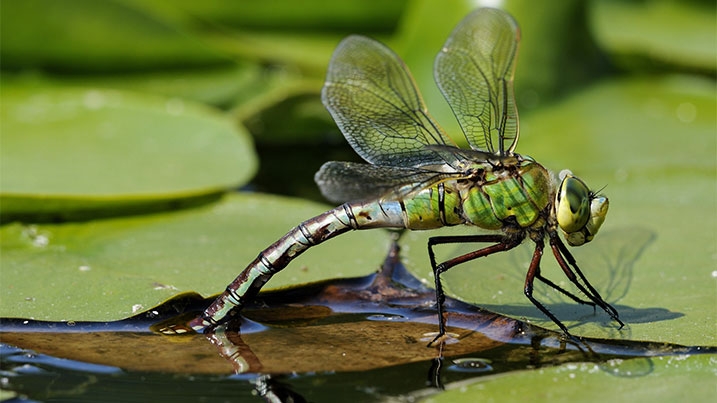
2. Go wild with aquatic plants
Aquatic plants are a dragonfly’s dream. To provide the best environment you’ll want a varied selection, so they support dragonflies at all stages of their life cycle. Oxygenating plants like spiked water-milfoil provide oxygen and cover for the larvae, while their emergent stems offer places for dragonflies and damselflies to lay their eggs. Floating plants like frogbit are great as dragonfly larvae love to hide under its leaves and along with marginals like bogbean they provide excellent egg-laying sites for the adults. Emergent marginal plants with tall stems like yellow flag iris are also important as dragonfly larvae use their stems to climb out of the water and emerge from their larval skin. They also provide perching, roosting and egg-laying sites for adults.
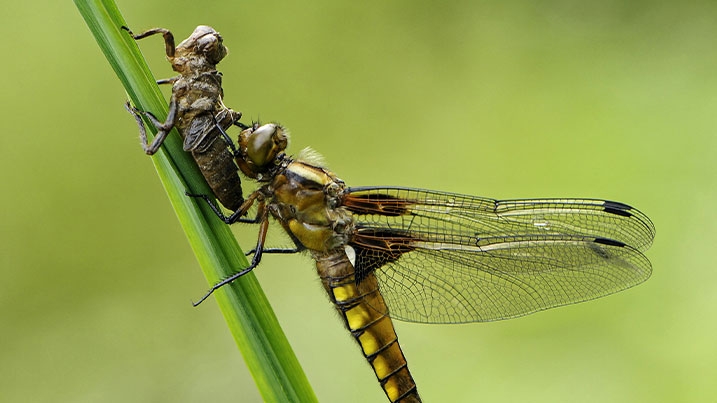
Always choose UK native plants. Because of widespread wetland drainage and the threat from non-native invasive species, many of our native wetland plants are struggling to survive. By giving them a home in your garden and using them in your planting scheme for your pond, you’ll be providing vital help to protect these native varieties. What’s more, these native plants will bring a fantastic splash of colour to your garden and create a really natural feel for your pond. And they help keep your pond water clean, clear, oxygen rich and free of algae.
3. Add some pond rocks for sunbathing
Like most of us, dragonflies enjoy a sunny spot to bask in! Flat stones placed near your pond give these sun-lovers a warm place to land and rest their wings. Sunbathing is essential for dragonflies because it helps them regulate their body temperature and keep those delicate wings in tip-top shape.
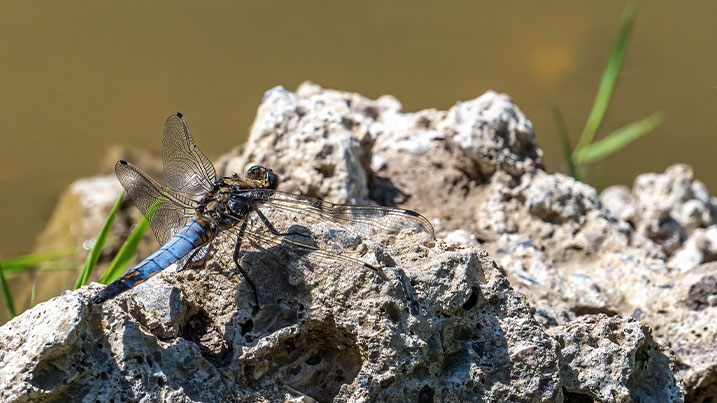
4. Let your pond get a little messy
Dragonflies and damselflies thrive in more natural, wild spaces. So don’t worry if your pond isn’t perfectly manicured. A bit of muck, dead leaves, and even algae in the water provide food for dragonfly larvae. These underwater critters love to lurk in the murky depths, waiting to grow into the dazzling aerial acrobats we all love. Keep things low-maintenance and embrace the wild!
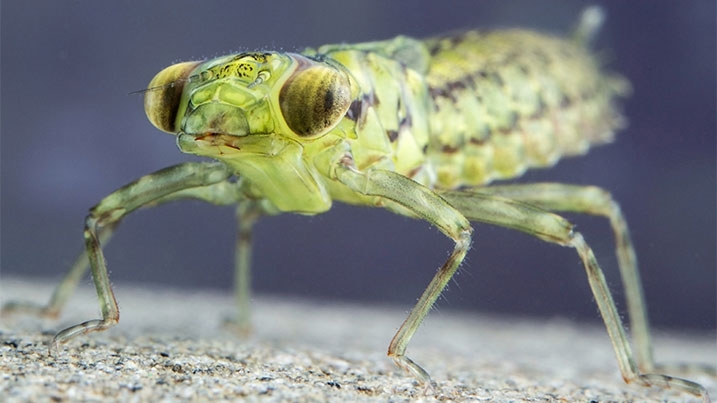
5. Create sheltered, sunny spots
Dragonflies and damselflies are all about sunbathing, but they also need shelter from the wind and bad weather. Plant some tall grasses, bushes, or even wildflowers around your pond to create natural windbreaks. Not only do these sheltered spots offer protection, but they also provide hunting perches and places to rest.
6. Let some grass grow tall
Leave a patch of your garden a little wilder with tall grass or plants. Dragonflies love having vertical plants to rest on, especially when they’re on the lookout for a meal. Damselflies, in particular, are known to perch on tall, slender stems. So, let your lawn get a little overgrown in some areas - it’s good for the bugs and looks beautifully wild!
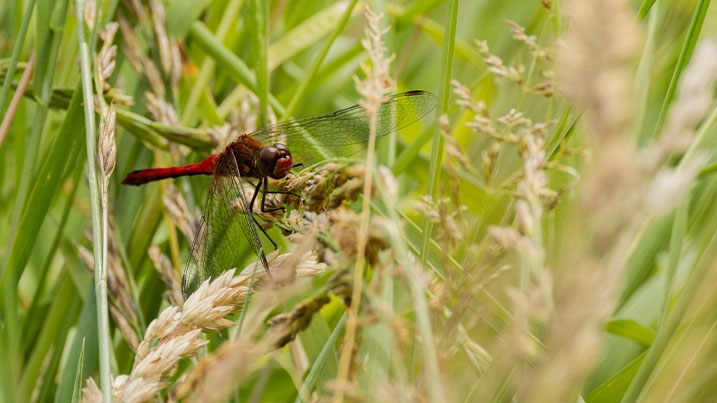
7. Build a mini waterfall or stream
While still water is essential for breeding, dragonflies and damselflies are also drawn to the sound and sparkle of gently flowing water. A small waterfall or stream flowing into your pond adds extra appeal, creating perfect spots for dragonflies to drink or bathe. This’ll also help oxygenate the water, allowing dragonfly larvae and their prey to thrive. Just keep the flow gentle – too much splashing and the larvae won’t enjoy it as much.
8. Install perching sticks
Dragonflies and damselflies love to perch! You can create perfect resting spots by placing sticks or plant stems near your pond. They’ll use these natural lookout points to scout for prey or find a mate. Plus, it’s great fun to watch them balance on their perches like tiny aerial hunters.

9. Welcome wildflowers
Wildflowers aren’t just pretty – they’re essential for attracting insects that dragonflies and damselflies love to eat. If your garden is buzzing with bees, butterflies, and other small insects, your dragonflies will be well-fed and more likely to stick around. Choose nectar rich native wildflowers with a simple, open flat structure like old cottage varieties like oxeye daisies and cornflowers, or red clover to create a feast for them and other wildlife.
10. Avoid chemical pesticides
Dragonflies and damselflies are brilliant natural pest controllers. They feast on midges and other small insects, making them perfect for keeping garden pests in check. However, using chemical pesticides can harm the delicate balance of your garden ecosystem. Stick to natural pest control methods, and let these amazing insects take care of the rest!
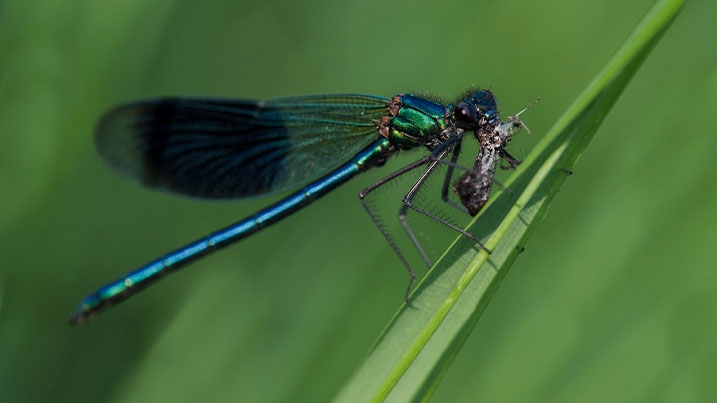
11. Provide a little shade
While dragonflies love the sun, they also need spots to cool down when the day gets too hot. Ensure there’s a mix of sunny and shaded areas in your garden, perhaps by planting a tree or adding shrubs. A little dappled shade gives them the best of both worlds and keeps your garden full of activity all day long.
Time to welcome your winged guests!
Attracting dragonflies and damselflies to your garden is not just a lovely way to boost biodiversity – it’s also endlessly fascinating to watch these beautiful insects flit about, bringing life and energy to your space. If you want to learn more about how to ID these captivating creatures, take a look at our easy to use guide.
Whether you go all-out with a pond or simply add a few wildflower patches, creating a dragonfly-friendly garden is both fun and rewarding. Let nature do its thing, and get ready for some aerial shows!
To see dragonflies in the wild and find out more about these wonderful insects, visit your local WWT wetland centre. Thanks to our carefully managed wetlands, dragonflies and damselflies are thriving across all our sites, with WWT London, WWT Caerlaverock and WWT Steart Marshes being designated hotspots by the British Dragonfly Society.
Plan your visit